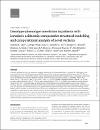Genotype-phenotype correlation in patients with isovaleric acidaemia: comparative structural modelling and computational analysis of novel variants.
| Author | Zaki, Osama K |
| Author | Priya Doss C, George |
| Author | Ali, Salsabil A |
| Author | Murad, Ghadeer G |
| Author | Elashi, Shaima A |
| Author | Ebnou, Maryam S A |
| Author | Kumar D, Thirumal |
| Author | Khalifa, Ola |
| Author | Gamal, Radwa |
| Author | El Abd, Heba S A |
| Author | Nasr, Bilal N |
| Author | Zayed, Hatem |
| Available date | 2017-10-11T07:24:05Z |
| Publication Date | 2017-08-01 |
| Publication Name | Human Molecular Genetics |
| Identifier | http://dx.doi.org/10.1093/hmg/ddx195 |
| Citation | Osama K. Zaki, George Priya Doss C, Salsabil A. Ali, Ghadeer G. Murad, Shaima A. Elashi, Maryam S.A. Ebnou, Thirumal Kumar D, Ola Khalifa, Radwa Gamal, Heba S.A. El Abd, Bilal N. Nasr, Hatem Zayed; Genotype–phenotype correlation in patients with isovaleric acidaemia: comparative structural modelling and computational analysis of novel variants, Human Molecular Genetics, Volume 26, Issue 16, 15 August 2017, Pages 3105–3115, https://doi.org/10.1093/hmg/ddx195 |
| ISSN | 0964-6906 |
| Abstract | Isovaleric acidaemia (IVA) is an autosomal recessive inborn error of leucine metabolism. It is caused by a deficiency in the mitochondrial isovaleryl-CoA dehydrogenase (IVD) enzyme. In this study, we investigated eight patients with IVA. The patients' diagnoses were confirmed by urinary organic acid analysis and the blood C5-Carnitine value. A molecular genetic analysis of the IVD gene revealed nine different variants: five were missense variants (c.1193G > A; p. R398Q, c.1207T > A; p. Y403N, c.872C > T; p. A291V, c.749G > C; p. G250A, c.1136T > C; p.I379T), one was a frameshift variant (c.ins386 T; p. Y129fs), one was a splicing variant (c.465 + 2T > C), one was a polymorphism (c.732C > T; p. D244D), and one was an intronic benign variant (c.287 + 14T > C). Interestingly, all variants were in homozygous form, and four variants were novel (p. Y403N, p. Y129fs, p. A291V, p. G250A) and absent from 200 normal chromosomes. We performed protein modelling and dynamics analyses, pathogenicity and stability analyses, and a physiochemical properties analysis of the five missense variants (p.Y403N, R398Q, p.A291V, p.G250A, and p.I379T). Variants p.I379T and p.R398Q were found to be the most deleterious and destabilizing compared to variants p.A291V and p.Y403N. However, the four variants were predicted to be severe by the protein dynamic and in silico analysis, which was consistent with the patients' clinical phenotypes. The p.G250A variant was computationally predicted as mild, which was consistent with the severity of the clinical phenotype. This study reveals a potentially meaningful genotype-phenotype correlation for our patient cohort and highlights the development and use of this computational analysis for future assessments of genetic variants in the clinic. |
| Language | en |
| Publisher | Oxford University Press (OUP) |
| Subject | Isovaleric acidemia phenotype-phenotype correlation genotype-phenotype associations phenotype metabolism genetics |
| Type | Article |
| Pagination | 3105–3115 |
| Issue Number | 16 |
| Volume Number | 26 |
| ESSN | 1460-2083 |
Files in this item
This item appears in the following Collection(s)
-
Biomedical Sciences [638 items ]



